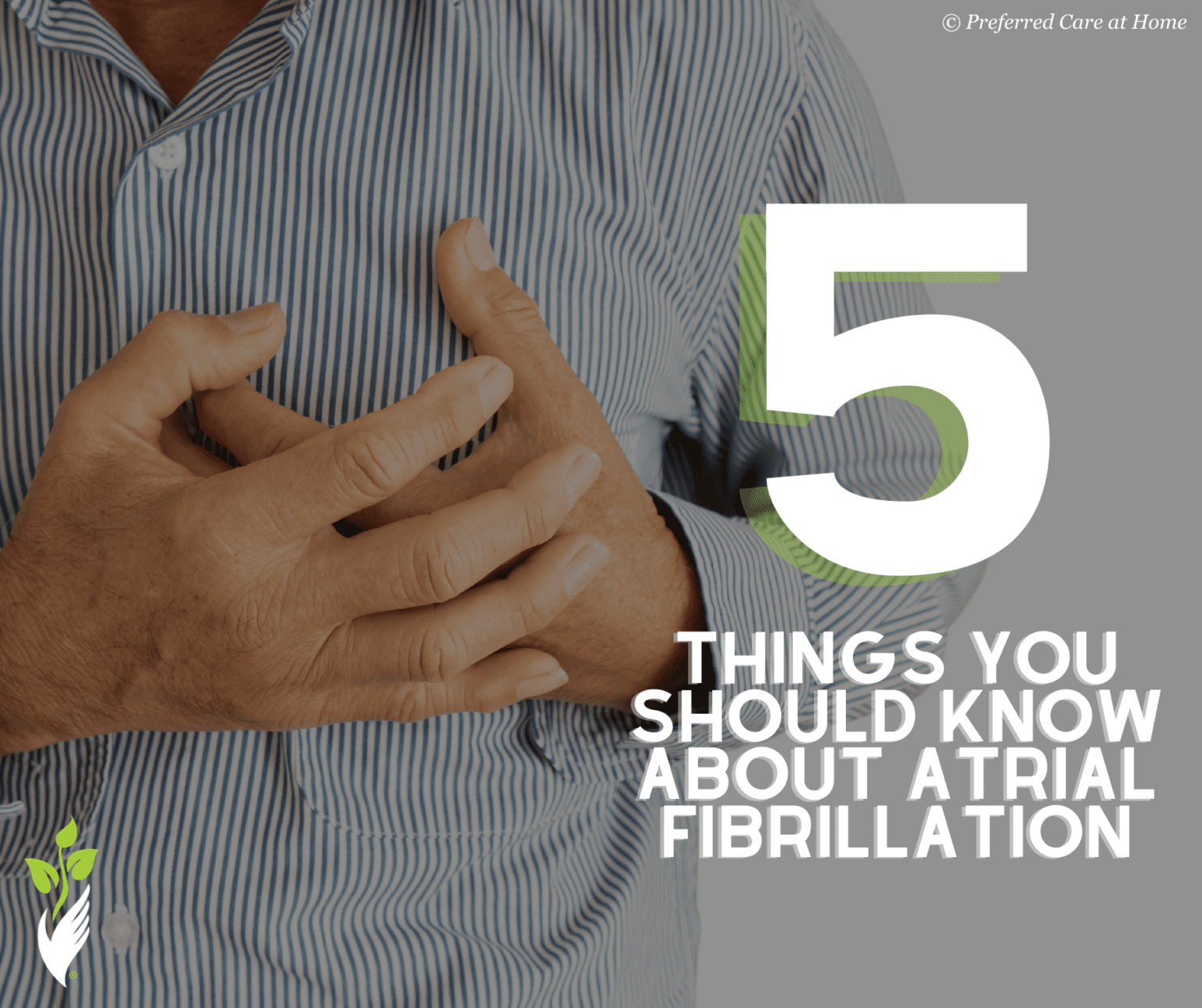Atrial Fibrillation: 5 Things You Should Know
Published September 16, 2021 by R. Bradley Robinson, M.D. in Senior Health & Wellness

September is set aside as National Atrial Fibrillation Awareness Month. Atrial fibrillation (AFib) is the most common cardiac arrhythmia (abnormal heartbeat) that affects mostly the adult population, and the prevalence is rising. In fact, by the year 2030 it is predicted that over 12 million Americans will have the diagnosis(1). Let’s take a closer look at AFib and talk about why proper management is critically important.
What is Atrial Fibrillation?
Atrial fibrillation is a type of irregular heartbeat. The heart beats without a particular pattern or predictable rhythm, and you may hear physicians call this an “irregularly irregular rhythm.” There are several subtypes of atrial fibrillation that range from paroxysmal/intermittent in which the irregular rhythm comes and goes over time, to persistent and then “long-standing atrial fibrillation” in which the irregular rhythm has lasted for >12 months. It is common for patients with intermittent atrial fibrillation to eventually progress to persistent and long-standing AFib, as the disease is typically progressive.
What is the consequence or significance of having AFib?
There are at least 2 important consequences of Atrial Fibrillation.
Firstly, the irregular heart rhythm predisposes to blood clot formation in a part of the heart called the left atrial appendage. If a clot forms, there is a risk it could break away and embolize to other blood vessels. Most significantly, this could result in a stroke if the clot embolizes to the cerebral blood vessels.
Secondly, the irregular rhythm can impact the overall function of the heart, and reduce its ability to pump effectively. The patient may experience this with non-specific symptoms such as light-headedness, fatigue, dizziness, and reduced exercise capacity. Other symptoms may include palpitations, tachycardia (fast heart rate), or shortness of breath.
What are the risk factors for developing Atrial Fibrillation?
Numerous studies have demonstrated that atrial fibrillation is closely linked to increasing age. It is incredibly uncommon to experience AFib before the age of 50 years.
However, in addition to age, several medical conditions are associated with the development of AFib. These include hypertension (high blood pressure), certain types of heart failure, and other cardiovascular diseases involving the heart muscle (i.e. cardiomyopathies) or heart valves (i.e. valvular heart disease). These usually result in enlargement of the left atrium chamber of the heart, which likely contributes to the development of atrial fibrillation. Certain modifiable risk factors such as excessive alcohol intake have also been shown to increase the probability of developing atrial fibrillation(2).
How is it diagnosed?
Traditionally, patients would present to a physician with symptoms of AFib, and the condition would be diagnosed based on a physical exam and ECG (electrocardiogram), a study used to evaluate the electrical activity and rhythm of the heart. If atrial fibrillation was suspected but not detected at the time of the office visit, a physician may prescribe a monitoring device to wear for a short time at home (usually a couple of days) to better detect the abnormal rhythm.
While the above process is still the standard of care, we are starting to see the potential for wearable devices to accurately detect AFib. The Apple Heart Study(3) is one such example, which enrolled over 400,000 individuals with an Apple Watch and iPhone who were not known to have a history of atrial fibrillation. The participants’ heart rhythm was tracked with an application on the watch, and if a rhythm of possible atrial fibrillation was detected, they underwent follow-up with a telemedicine visit and (if clinically confirmed) an ECG patch recording device to confirm the heart rhythm. Of those who were notified of an irregular heart rhythm by the watch, 84% were ultimately concordant with the diagnosis of atrial fibrillation. While further research in this area is ongoing, it shows promise as a new wave for screening and detecting AFib.
How is it treated?
As we have discussed, atrial fibrillation is an abnormal heart rhythm that can cause many symptoms and carries a significant risk for stroke. Left untreated, atrial fibrillation will usually cause the heart to beat too fast. Treatment mostly focuses on 1) correcting the abnormal rhythm or 2) controlling the fast heart rate.
There are several strategies for correcting the abnormal rhythm including medications and/or procedures. If your physician is able to localize a specific part of the heart that is causing the abnormal rhythm, it may be possible to ablate this area using a minimally invasive procedure or perform surgery to disrupt the area causing the problem. The decision to pursue this mode of treatment involves many factors, including your own preferences, so be sure to discuss risks/benefits as well as the success rates for each method of treatment. If rhythm control is not successful, the alternative approach involves controlling the heart rate from becoming too fast. This is often managed with medications, though some minimally invasive procedures are available for this as well depending on the scenario.
Because of the risk of stroke, it is important to thoroughly evaluate each patient with AFib and determine whether anti-coagulant medications (‘blood thinners’) are needed. Your physician may use risk calculators which are well-validated to help guide his or her treatment recommendation.
The most important thing to understand is that the treatment decisions for AFib can become complex, and are best handled by a thorough evaluation from a physician who is experienced in treating atrial fibrillation. It is important to discuss your goals and preferences and to be on the same page with your physician when starting a new treatment plan.
(1) https://www.cdc.gov/heartdisease/atrial_fibrillation.htm
(2) Alcohol and Atrial Fibrillation: A Sobering Review. Voskoboinik A, Prabhu S, Ling LH, Kalman JM, Kistler PM J Am Coll Cardiol. 2016;68(23):2567.
(3) Large-Scale Assessment of a Smartwatch to Identify Atrial Fibrillation. Perez MV et. al. Apple Heart Study Investigators. N Engl J Med. 2019;381(20):1909.
If you have questions about senior home
care services or if you want to start care:
Related Posts

November 9, 2023
Celebrating Robert Louis Stevenson’s Birthday: Exploring the Legacy of ‘Jekyll & Hyde
Ashly Luckose, Esq.

November 3, 2023
Visiting Grandparents During the Holidays: Preparing Kids with Books on Aging
Gina Farmer

October 19, 2023
Preventing Osteoporosis: Essential Tips for Stronger Bones Post-Menopause
R. Bradley Robinson, M.D.
Helping seniors age in place, with dignity & grace.